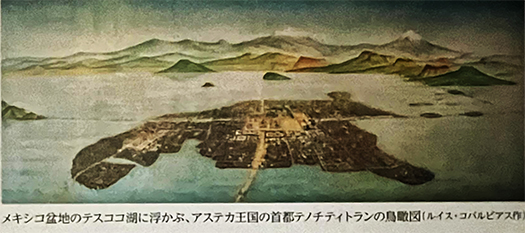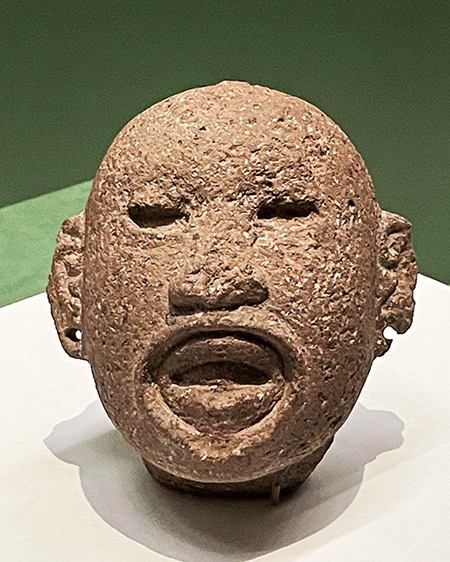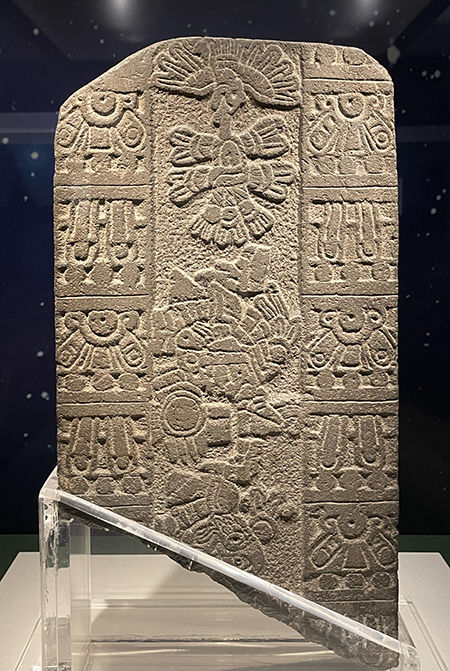

人類の進化史のなかではさまざまな宗教が生まれ、独特の価値体系が民衆に信じられていた。中米のアステカはそういうなかでも特異な存在だろう。日本の戦国時代に相当する時代に発生したこの文化圏は、周辺地域に対して非常に好戦的に戦争を仕掛け、多量の捕虜を収奪してきては、かれらの宗教儀式において残酷な儀式を繰り返していたとされている。1325年、アステカ人たちはメキシコ中央高原・テスココ湖を埋め立て水上都市テノチティトラン(現在のメキシコの首都メキシコ・シティー)を建設した。アステカは、テスココとトラコパンというふたつの都市国家と「3市同盟」を組むと、周辺国家に戦争を仕掛け、メキシコ中央高原全体へと勢力を広げた。王都テノチティトランの人口は30万人に達し、人々の生活水準はヨーロッパのどの都市よりも高かったといわれる。
日本でも織田信長が、滅ぼした敵将の頭蓋骨を酒の容器にして臣下に飲ませていたという説話はあるし、伊勢長島での一向宗への復讐にも感じられる残虐な皆殺しを行ったという事実もある。信長は自ら神となることを祈念していたと伝えられる。中国大陸国家では項羽の集団虐殺も語り継がれている。
そういったいわば「戦争メンタリティ」の結果の事実は人類普遍の逸話として確認できるけれど、アステカではそれに宗教性が刻印されて、神への捧げ物として人間が生け贄とされていたという。あんまり興味を持ちたくない領域だったのですが、今回のシリーズでやむなく調べていると、やはり内容は敬遠したくなる次第。

こちらは「シペ・トテック神の頭像」。シペ・トテックというのは「皮を剥がれたわれらが主」という意味で、生け贄となった人間の皮をまとう神だという。アステカの王たちは戦争に当たって、この神に憑依して戦ったのだという。
日本では戦争に当たっては「大義名分」という倫理規範が謳われる。戦うことは正義の実現のためであるという価値感が重要視されたわけだろう。官軍・賊軍みたいに正義と悪という設定が重視された。
しかしこのシペ・トテックにはやや飛躍があるように感じられる。その民族の宗教心に対してはリスペクトは持ちつつ、しかし違和感が存在することは否めない。

夜空の石版と名付けられたこの石版には、太陽神信仰であるかれらの価値感が表出されている。夜空を主題として両脇には金星と星、中央にはワシと兵士が表されている。戦争や生け贄として亡くなった兵士の魂は、太陽と共に天球上を永遠に旅しなければならなかった。
アステカなどの古代メキシコの人びとが帰依した宗教についてはその教義体系が断続しているとされるので、想像力を持ちにくいけれど、ほかの宗教一般が「救済」をテーマとしているのに対して、どうも基本的なテーマ性に違いがあると思えてならない。
日本神話で言えばイザナギ・イザナミの神話、先に死んだイザナミを黄泉の世界まで探しに行ったイザナギが魔物に追われる、みたいな神話メンタリティに近いのではないかとは思っているけれど、基本的人権という世界標準が確立した世界では、なかなか想像しにくいのでしょうね。
English version⬇
Aztec Sun Worship, Ancient Mexico, Different from World Religions
The universal value of world religions is the system of thought that rescues people from the suffering of this world. Ancient Mesoamerica, on the other hand, was led by a unique worldview. On the other hand, ancient Mesoamerica was led by a unique worldview.
In the history of human evolution, various religions have emerged and unique value systems have been believed by the people. The Aztecs of Central America are unique among these. In 1325, the Aztecs reclaimed Lake Tescoco in the central Mexican plateau and built the city of Tenochtitlan (now the capital of Mexico) on the water. In 1325, the Aztecs reclaimed Lake Tescoco in the central Mexican plateau and built the city of Tenochtitlan (now Mexico City, the capital of Mexico) on the water. The Aztecs formed the “League of Three Cities” with the two city-states of Tescoco and Tlacopan, and then launched a war against the neighboring states, expanding their power throughout the central Mexican plateau. The population of Tenochtitlan, the royal capital, reached 300,000, and the standard of living was said to be higher than in any European city.
In Japan, there is a story that Nobunaga Oda used the skulls of enemy generals he had destroyed as containers for his subjects to drink sake, and there is also the fact that he brutally killed everyone in Ise Nagashima, in what felt like revenge against the Ikkyu sect. Nobunaga is said to have prayed to become a god himself. In the Chinese mainland states, the massacre of Nemu is also told.
The fact that such a “war mentality” resulted can be confirmed as a universal human anecdote, but in the Aztecs, it was stamped with religiosity, and human beings were sacrificed as offerings to the gods. It was an area that I did not want to be too interested in, but when I was compelled to look into it for this series, I still wanted to avoid the content.
This is the “Head Statue of the God Sipe Totek. The name “Sipe Totec” means “flayed lord,” and the god is said to wear the skin of a sacrificed human being. It is said that Aztec kings fought wars possessed by this god.
In Japan, the ethical code of “justice” is often advocated in wars. The sense of value that fighting is for the realization of justice must have been considered important. The setting of righteousness and wickedness was emphasized, as in the case of the government army and the bandit army.
However, this sipé Totec seems to be a bit of a leap. While I respect the religious beliefs of the people, I cannot deny that there is a sense of discomfort.
This tablet, named the Night Sky Tablet, expresses their sense of value as sun god worshippers. The night sky is represented by Venus and stars on both sides, and an eagle and a soldier in the center. The souls of soldiers who died in war or as sacrifices had to travel with the sun through eternity on the celestial sphere.
It is difficult to imagine the religions to which the Aztecs and other ancient Mexican peoples turned because their doctrinal systems are said to have been intermittent, but I cannot help thinking that there is a difference in the basic theme of these religions compared to other religions in general, which focus on “salvation” as their theme.
In Japanese mythology, it is similar to the myth of Izanagi-Izanami, in which Izanagi goes to Hades to look for Izanami, who died first, and is chased by demons.
Posted on 9月 26th, 2023 by 三木 奎吾
Filed under: 歴史探訪







コメントを投稿
「※誹謗中傷や、悪意のある書き込み、営利目的などのコメントを防ぐために、投稿された全てのコメントは一時的に保留されますのでご了承ください。」
You must be logged in to post a comment.